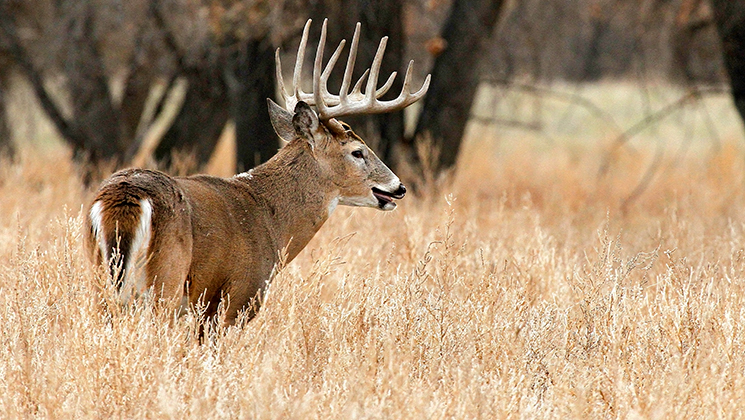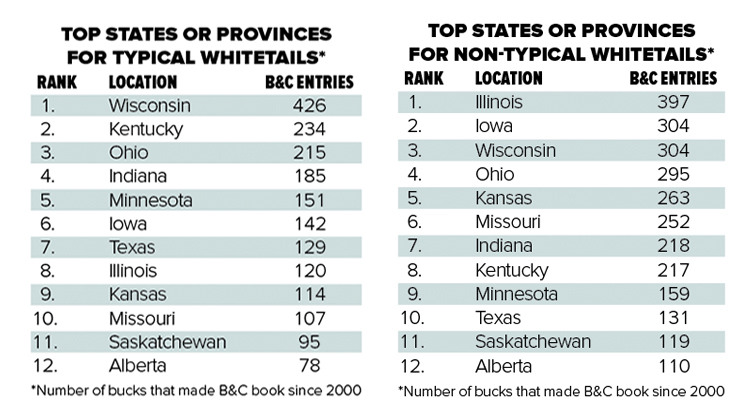
A friend has this jaw-dropping non-typical whitetail hanging in his den. The rack has 44 scorable points and a 25⅛-inch inside spread. The first time I saw it hanging over a brick fireplace I couldn’t take my eyes off the gnarly thing.
When I asked where he got the monster he just shrugged and said nonchalantly, “Oh, I’ve shot a few big deer.”
“But what does this thing score?”
“333⅞ Boone and Crockett Club points.”
“What? Wait a second.”
He walked away from me as he cavalierly tried to change the subject. He was playing the man of mystery and such types don’t answer direct questions. He was suddenly the most interesting man in the world and that was okay with him. All he needed was a smoking jacket, a glass of single-malt and a cigar.

The thing was I recognized the buck.
“That’s a famous buck, isn’t it? I’ve seen it before.”
He smiled bashfully, dropped the act and confessed that it is a replica of the “Missouri Monarch,” a buck found dead in 1981. It’s the world-record non-typical.
“Why do you have a replica of the Missouri Monarch?”
“Best one ever, you know … I just wanted it,” he said.
I nodded knowing there was no need to probe deeper, as there was a shared understanding between us. He was drawn to it and knew he’d never kill a buck like that. Sure, he’d taken some fine deer—a few hang in his den alongside African game and an impressive elk—but he wanted a star whitetail for his collection so he bought a replica.
The desire for big deer can make us do things that might seem strange to someone who doesn’t have the fever for big deer. I recall a mount of a giant I saw slowly spinning on a coffee table in the living room of a double-wide in Iowa. That buck was real, but the guy had to constantly shift his head as it slowly spun under a light so he could watch his TV—oh yeah, he was single.
This isn’t to say the desire for big antlers is a bad thing. Actually, managing deer so we grow a few studs is a healthy way to manage a herd. To get a few bucks to reach their potential we have to make sure the herd doesn’t exceed the carrying capacity of the land. This type of careful quality deer management helps all the flora and fauna in an ecosystem, even non-game species, as it prevents deer from browsing away the vegetation. For this reason alone it is a good thing to be a trophy hunter.
So it is helpful to conservation that some of us pay to go to areas that grow big deer or try to manage the deer in our backyards better. The impacts from this desire benefit ecosystems all over America—so much so that there are now more true monster whitetails in America than ever before. Incredibly, more whitetails have made the Boone and Crockett Club’s (B&C) Records of North American Big Game since 2000 than in the entire 20th century combined.

Actually, the places that now have the potential to grow a few whitetail bucks big enough to qualify for the B&C’s record book defy lists, as such bucks now come from all over the whitetail’s range. In the 1980s we could have listed a few counties in Illinois, Wisconsin, Iowa, Texas and a few other states and Canadian provinces as we told you to find a great lease or outfitter in those areas. Today the list is too long and complicated to easily sum up. So though we break this article into the top places, please note that some areas within other states are just as hot; in fact, we’ll mention as many as these as we can fit.
“Dream hunts are out there. To match each hunter to the right experience we measure each hunter’s expectations,” says Greg Ray, founder of Outdoor Solutions, an outdoor booking agency. “Some whitetail hunters, especially from the East, have never seen a 130- or 140-inch buck. To them an 8- or 10-pointer in that range is a dream buck. Others who’ve already killed bucks like that dream of a 150 or bigger. Those are different hunts. We place hunters accordingly. The cool thing is that opportunities are constantly evolving. Right now one of my new go-to places is in western Kansas.”

To help you narrow down the choices to find your dream whitetail hunt, this article uses several sources. First, we drew on advice from outfitters and booking agents. Next came experts at the Quality Deer Management Association (QDMA), which compiles an annual “Whitetail Report” you can find at QDMA.com. Next we used research done by B&C that counts the number of qualifying entries from each state and county.
The Regulation Factor
The list of top states for big whitetails overall hasn’t changed much in the last few decades, but the number of B&C giants shot has exploded; in fact, new states are now shooting more B&C bucks than hunters in the top dozen states were tagging just a few decades ago.
In case you’re wondering, Michigan and Nebraska tied for 13th place overall with 49 typical whitetail bucks making book since 2000. Arkansas was 14th and, this might be a little surprising, Mississippi and Pennsylvania were 15th and 16th, respectively—as this article was being written Mississippi had 37 typical whitetails make book since 2000 and Pennsylvania had 32. (They both beat Oklahoma’s 27.)

A big reason for this is the growth of QDMA practices and hunter knowledge about managing a deer herd for quality. Another factor pushing these trends is that both Mississippi and Pennsylvania instituted state-wide antler-point restrictions, a factor that not only protects yearling bucks but that also results in greater awareness of quality deer management practices.
The QDMA reports that today at least 23 states and one province have some form of antler restrictions. The QDMA emphasizes that “antler restrictions are not synonymous with Quality Deer Management. Rather, antler restrictions are a strategy to protect a specific age class (generally yearlings) or classes of bucks.” Still, these regulations result in vociferous debates between hunters, which raises awareness about managing for older-age-class bucks.
What this means is modern-day deer hunters are more knowledgeable than ever and are demanding more intensive management programs from their state or provincial wildlife agencies.

Even New York state, which has some areas with antler-point restrictions, had 21 bucks make the B&C book since 2000. Still, the restrictions aren’t the explanation, as many of the bucks that made book from New York weren’t shot in the antler-point restriction area. Rather, antler-point restrictions are part of a statewide discussion among hunters in general that fosters an awareness that causes more hunters to pass on young bucks.
Nevertheless, New York has a long way to go. In 2016 an astounding 49 percent of the bucks taken in New York were yearlings—this tied Virginia and is the third most behind Wisconsin (65 percent) and New Hampshire (51 percent).
Incredibly, the percentage of yearling whitetail bucks in the overall nationwide harvest has fallen from 62 percent in 1989 to just 35 percent in 2016. These numbers have stabilized in recent years, but the percentage should fall again if another state implements or increases the amount of area regulated with some kind of antler restrictions to protect young bucks.

The QDMA also reports that 22 states provided them with their whitetail herd’s age-structure data. The organization found that nationwide, 3½-year-old and older bucks made up 34 percent of the buck harvest in 2016. Today an amazing one of every three antlered bucks shot in the U.S. is at least 3½ years old. Hunters have come a long way in a few decades.
Top States for B&C Bucks Today
By using the B&C “Trophy Database” (you can access this astounding database for a subscription fee of $50) we narrowed down the search. This database is fun for a whitetail fanatic. Ever wonder what the greatest inside spread ever was for a whitetail? A buck shot in Ashtabula County, Ohio, in 1957 still has the top spot with a spread of 38⅛ inches.

Aside from looking up the features on the biggest bucks ever you can also see what locations are hot now. The non-typical category offers a smaller sample size, but it tells a lot about local genetics. The non-typical list also includes more states; whereas the top counties for typical bucks from 2007-2017 are completely controlled by Wisconsin and Texas. You have to go down the county list to No. 16 before you find a county from another state (Houston County, Minn.). The first county in the East is way down at No. 186 (Beaver County, Pa.) with four entries in the 11-year period.
Now, bucks that make B&C minimums aren’t exactly statistical anomalies, but they are very exceptional. The thing is if an area has more B&C entries than other areas, this tells you there are likely a lot more bucks reaching their potential in that region. For a buck to reach B&C class it usually has to reach maturity (typically this means it must be at least 5 years old), it must have enough nutrition to grow all that antler and it must have the genetics to get there. Even when all of those factors are met only a very few bucks are going to grow into B&C-qualifying monsters. Still, many more will be mature and awesome trophies.

“Outfitters rise and fall on their leases, game-management practices and more,” says Greg Ray. “We keep close tabs on them because the experience and the bucks they offer can change dramatically from one season to the next. I’ve see divorces wreck an outfitter. I’ve seen a few lose leases or experience an outbreak of severe epizootic hemorrhagic disease. This is why we constantly visit and talk to our outfitters and why we’re always looking for new quality outfitters. Hunters today either really need to do their research or they need to use a booking agency like ours, as we do the work for them.”
Here’s a rundown of where to go in the top 10 states that over the last decade produced the greatest number of whitetail B&C entries.
1. Wisconsin
Wisconsin is easily the top producer of B&C whitetails. (Realize, though, that comparing one state to another is hardly an apples-to-apples comparison, as states vary in size.) What you’ll find in areas that grow huge deer is the best land is spoken for. To get the highest odds you’ll have to compete for a lease or hire a quality outfitter. Still, Wisconsin does have a substantial amount of public land that also grows some monsters. A hunter who is willing to research and possibly out-walk and out-hunt others can find big bucks on state and federal lands in this big-deer state.
2. Kentucky
Hunters in Kentucky have killed 345 bucks that made the B&C’s record-book minimum since 2010 alone. Ohio, Casey, Pulaski, Shelby and Whitley have been the top counties for B&C entries. Kentucky is a one-buck state, but you can take as many antlerless deer as you like in Zone 1 regions. The state’s bow season generally goes from Sept. 2-Jan. 15.
3. Ohio
Since 2010 hunters in Ohio have logged 370 bucks that made B&C’s minimum score for typical and non-typical whitetails. Highland County is one of the best for non-typicals over the last decade. As with many Midwestern states, Ohio’s bow season starts well before the rut and goes for several months. The state’s firearm seasons, however, are short and in the post-rut. This is likely part of the reason why Ohio is so high on this list. The state also restricts hunters to one buck per year.
4. Indiana
For B&C bucks Jasper, Parke, Fayette and Delaware counties rate high in the typical-buck list over the last decade. This is a state that often flies beneath the big-buck radar. While the peak of the rut occurs during an archery-only season, the first portion of the firearm season falls in the last part of the rut. Hunters have taken 291 B&C-qualifying bucks in the state since 2010. Indiana also has more than 55,000 acres of public land.
5. Iowa
Iowa is a well-known big-buck producer. Hunters there have killed 264 B&C-qualifying bucks since 2010. Tags are allocated via lottery. Nonresident hunters often must spend three or four years accruing preference points before they draw a tag in Iowa. Buck tags also require purchasing an anterless permit. Allamake County ranks 21st in the top counties list for typical B&C bucks over the last decade. Clayton County is at No. 35. Warren, Winneshiek, Davis and Decatur Counties also rate high.
Only bowhunters have the opportunity to hunt the rut in Iowa, but a lot of monsters are killed in the state’s muzzleloader season. Iowa also has about 300,000 acres of public land that does produce some giants.
6. Minnesota
Minnesota has a lot of land open to the public in its northern third. Still, a lot of the bucks that make B&C minimums come from the state’s southeastern corner—near Wisconsin’s legendary Buffalo County. A total of 230 bucks have made B&C’s minimums in the state since 2010. It’s big-woods hunting in northern Minnesota, but the big deer are in that sprawling northern country.
7. Illinois
The Land of Lincoln’s “Golden Triangle” of Pike, Brown and Adams counties is well-known but still is a top region, especially for bowhunters. Bureau County and Fulton County are high up in the list of top counties for typical B&C bucks. Since 2010 a total of 240 whitetails have made B&C’s minimums from the state—exactly 120 typicals and 120 non-typicals. A lot of big bucks are taken during the state’s gun and muzzleloader seasons, but its long archery season gives bowhunters a lot of time to scour the woods.
8. Kansas
Kansas first appeared on the list for big whitetails in the 1990s. Since 2010 hunters have killed 239 whitetails that made the B&C’s book. To get a buck tag in Kansas nonresident hunters must apply for a tag. It is not as hard to draw a tag as it is in Iowa, but good areas can take a few years. Lyon and Riley counties have had a good number of bucks make book over the last decade. Alternately, research top-rated outfitters—the state has some good ones. The state also has a lot of public lands and hundreds of thousands of acres open to hunters via landowner-access programs.
9. Missouri
A total of 210 bucks killed in Missouri have made book since 2010. This is a two-buck state; one of the two must be taken with archery gear. There are antler-point restrictions (a minimum of four points on at least one side) in many counties. Chariton, Lincoln, St. Charles, Worth and Miller counties are top big-buck producers. Nonresidents needn’t go through a draw process for a tag here.
10. Texas
South Texas’ ranches are known to grow some giants; still, this state just barely made the top 10 list for typical bucks. Hunters in Texas have killed 200 bucks since 2010 that made book. The majority of these came from Maverick (28), La Salle (24), Webb (23), Dimmit (20) and Kleberg (11) counties. Hunting whitetails on a Texas ranch is a different experience and can be pricey. A side benefit to hunting on a Texas ranch is the hunt often includes the opportunity to kill whitetail does, wild pigs and possibly javelinas.
You might have noticed no Canadian provinces made this top 10 list. Actually, Saskatchewan ranked No. 11 and Alberta was 12th in B&C’s ranking of most typical bucks taken since 2010. Parts of Canada are top B&C buck producers, but statistically they are a little farther down on the list.
Whether you travel or stay local to hunt, finding or managing a property (which might include making an agreement with other landowners) with quality in mind is the key to taking bucks most of us would be proud to hang on a wall.




































